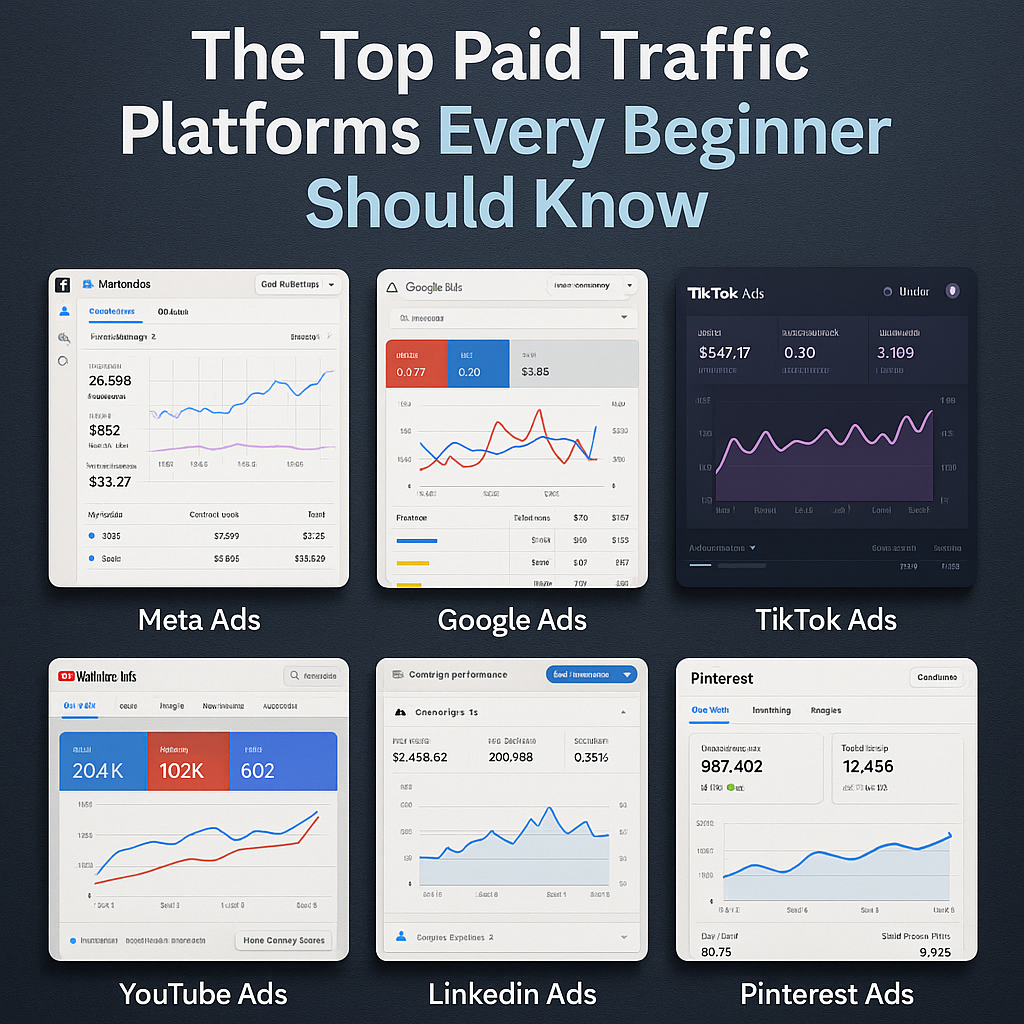If you’re starting your journey as a traffic manager, one of the most important things to understand is the variety of platforms where you can run ads. Each platform has its own advantages, audience behavior, ad formats, and learning curves.
In this guide, we’ll explore the top paid traffic platforms every beginner should know — including when to use each one, what types of ads they offer, and what makes them effective.
- Meta Ads (Facebook & Instagram)
Overview:
Meta Ads is the combined advertising system for Facebook and Instagram, and it’s one of the most versatile ad platforms available.
Why It’s Great for Beginners:
Easy to set up a basic campaign
Massive reach across different demographics
Visual formats perfect for storytelling
Powerful targeting based on interests, behaviors, and custom audiences
Best For:
Local businesses
Online services
Digital products
E-commerce
Brand awareness
Ad Types:
Image & video ads
Carousel ads
Stories and Reels
Collection ads
Messenger ads
Tip:
Use Facebook Pixel on your landing pages to track conversions and optimize campaigns effectively.
- Google Ads
Overview:
Google Ads allows you to advertise across Google Search, YouTube, Gmail, Maps, and the Display Network. It’s the go-to platform for search intent — meaning people are actively looking for something you offer.
Why It’s Powerful:
High buyer intent on search ads
Access to Google’s massive ecosystem
Precise keyword targeting
Strong analytics through Google tools
Best For:
Lead generation
High-ticket services
Search-driven industries (lawyers, dentists, consultants)
YouTube marketing
Ad Types:
Search ads (text)
Display ads (image banners)
Video ads (YouTube pre-roll, in-stream)
Shopping ads (e-commerce)
Performance Max campaigns
Tip:
Use Google Keyword Planner to research search volumes and bid competition before launching campaigns.
- TikTok Ads
Overview:
TikTok is one of the fastest-growing platforms in the world, especially among Gen Z and millennials. Its ad platform is relatively new but very effective for short-form, high-impact videos.
Why It’s Exploding:
Extremely high engagement
Creative and fun ad culture
Affordable CPMs (Cost per Thousand Impressions)
Virality potential
Best For:
Fashion
Fitness
Beauty and skincare
Online challenges and trends
Mobile apps and games
Ad Types:
In-feed video ads
TopView ads (first ad users see)
Branded hashtag challenges
Spark ads (boosting organic creator content)
Tip:
Use native-looking creatives — don’t make your ad “look like an ad.” TikTok users respond better to authentic, story-based content.
- YouTube Ads
Overview:
YouTube is part of the Google Ads ecosystem, but it deserves a separate spot because of its video dominance. It’s a video search engine, making it ideal for educational or story-driven campaigns.
Why It Works:
Huge audience
Strong targeting via search and interests
Long video content allows deeper messaging
Can be used for both branding and direct response
Best For:
Course creators and educators
SaaS companies
Health, finance, and real estate
Tutorials and how-to content
Ad Types:
Skippable in-stream ads
Non-skippable in-stream ads
Discovery ads (appear in search results)
Bumper ads (6-second unskippable)
Tip:
Use strong hooks in the first 5 seconds — that’s when viewers decide whether to keep watching or skip.
- LinkedIn Ads
Overview:
LinkedIn is the #1 platform for B2B advertising. If you’re trying to reach professionals, executives, or business decision-makers, this is the place to be.
Why It’s Unique:
Detailed job-based targeting
Great for high-value leads
Less competition than Meta or Google in some niches
Ideal for whitepapers, webinars, and demos
Best For:
B2B services
SaaS tools
Financial or legal services
Recruiting and HR solutions
Ad Types:
Sponsored content
Message ads (InMail)
Text ads
Dynamic ads (personalized)
Tip:
Focus on lead generation forms and high-value content to build trust before going for the sale.
- Pinterest Ads
Overview:
Pinterest is a highly visual discovery platform. While often overlooked, it works well for lifestyle brands, DIY, home decor, and wellness.
Why It’s Effective:
Strong user intent — people use Pinterest to plan purchases
Great for evergreen content
Higher conversion rates in certain niches
Best For:
E-commerce (home decor, fashion, cooking tools)
Blog traffic
Wedding or event services
Digital products for women-focused audiences
Ad Types:
Promoted pins
Carousel pins
Video pins
Shopping pins
Tip:
Focus on vertical, clean visuals with helpful text overlays.
- Twitter/X Ads (Optional for Niche Use)
Twitter (now X) has a smaller, more specialized audience, but it can be effective in certain niches like:
Crypto and finance
Breaking news
Influencer engagement
Tech communities
It’s not ideal for most beginners, but worth exploring if your audience is highly active there.
Choosing the Right Platform as a Beginner
Each platform has its pros and cons. Here’s a quick breakdown to help you decide:
Goal Best Platform(s)
Fast testing & reach Meta Ads, Google Ads
Professional leads LinkedIn Ads
Gen Z engagement TikTok Ads
Video storytelling YouTube Ads
Visual shopping Pinterest Ads
Search-based buyers Google Search Ads
Start by focusing on one platform. Master it, test campaigns, and build your skillset. Once confident, you can expand into others and combine them for multi-platform strategies.
Final Thoughts: Start Where You Can Win
As a beginner traffic manager, you don’t need to learn every ad platform at once. The smartest move is to start with one that aligns with your target market, learn it deeply, and build your portfolio around results.
Clients don’t hire people who know every tool — they hire people who can get results using the right tools. Master one platform, build confidence, and then expand.
